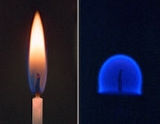
International Space Station
Overview
Satellite
In the context of spaceflight, a satellite is an object which has been placed into orbit by human endeavour. Such objects are sometimes called artificial satellites to distinguish them from natural satellites such as the Moon....
in low Earth orbit
Low Earth orbit
A low Earth orbit is generally defined as an orbit within the locus extending from the Earth’s surface up to an altitude of 2,000 km...
. The ISS follows the Salyut
Salyut
The Salyut program was the first space station program undertaken by the Soviet Union, which consisted of a series of nine space stations launched over a period of eleven years from 1971 to 1982...
, Almaz
Almaz
The Almaz program was a series of military space stations launched by the Soviet Union under cover of the civilian Salyut DOS-17K program after 1971....
, Cosmos
Cosmos 557
Kosmos 557 was the designation given to DOS-3, the next space station in the Salyut program. It was originally intended to be launched as Salyut-2, but due to its failure to achieve orbit on May 11, 1973, three days before the launch of Skylab, it was renamed Kosmos-557.Due to errors in the flight...
, Skylab
Skylab
Skylab was a space station launched and operated by NASA, the space agency of the United States. Skylab orbited the Earth from 1973 to 1979, and included a workshop, a solar observatory, and other systems. It was launched unmanned by a modified Saturn V rocket, with a mass of...
, and Mir
Mir
Mir was a space station operated in low Earth orbit from 1986 to 2001, at first by the Soviet Union and then by Russia. Assembled in orbit from 1986 to 1996, Mir was the first modular space station and had a greater mass than that of any previous spacecraft, holding the record for the...
space stations, as the 11th space station launched, not including the Genesis
Genesis II
Genesis II is a 1973 American TV film created and produced by Gene Roddenberry and directed by John Llewellyn Moxey.It opens with the line, "My name is Dylan Hunt...
I and II prototypes. The ISS serves as a research laboratory that has a microgravity environment in which crews conduct experiments in many fields including biology
Biology
Biology is a natural science concerned with the study of life and living organisms, including their structure, function, growth, origin, evolution, distribution, and taxonomy. Biology is a vast subject containing many subdivisions, topics, and disciplines...
, human biology
Human biology
Human Biology is an interdisciplinary area of study that examines humans through the influences and interplay of many diverse fields such as genetics, evolution, physiology, epidemiology, ecology, nutrition, population genetics and sociocultural influences. It is closely related to...
, physics
Physics
Physics is a natural science that involves the study of matter and its motion through spacetime, along with related concepts such as energy and force. More broadly, it is the general analysis of nature, conducted in order to understand how the universe behaves.Physics is one of the oldest academic...
, astronomy
Astronomy
Astronomy is a natural science that deals with the study of celestial objects and phenomena that originate outside the atmosphere of Earth...
and meteorology
Meteorology
Meteorology is the interdisciplinary scientific study of the atmosphere. Studies in the field stretch back millennia, though significant progress in meteorology did not occur until the 18th century. The 19th century saw breakthroughs occur after observing networks developed across several countries...
. The station has a unique environment for the testing of the spacecraft systems that will be required for missions to the Moon and Mars.
Unanswered Questions

